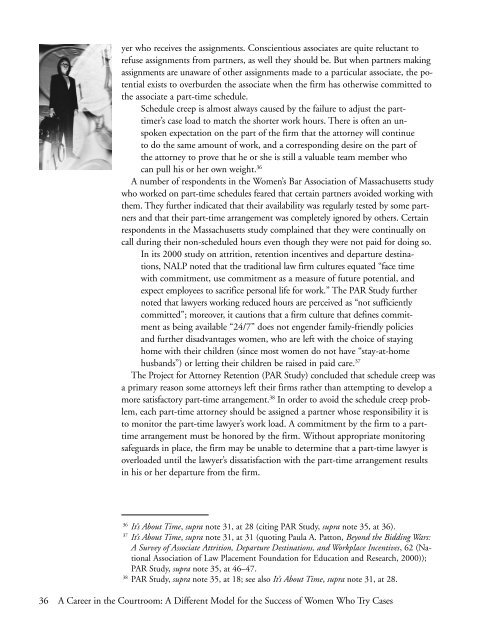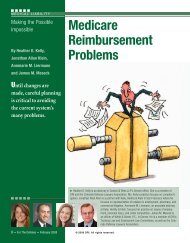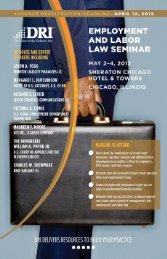A Career in the Courtroom: A Different Model for the Success ... - DRI
A Career in the Courtroom: A Different Model for the Success ... - DRI
A Career in the Courtroom: A Different Model for the Success ... - DRI
Create successful ePaper yourself
Turn your PDF publications into a flip-book with our unique Google optimized e-Paper software.
yer who receives <strong>the</strong> assignments. Conscientious associates are quite reluctant to<br />
refuse assignments from partners, as well <strong>the</strong>y should be. But when partners mak<strong>in</strong>g<br />
assignments are unaware of o<strong>the</strong>r assignments made to a particular associate, <strong>the</strong> potential<br />
exists to overburden <strong>the</strong> associate when <strong>the</strong> firm has o<strong>the</strong>rwise committed to<br />
<strong>the</strong> associate a part-time schedule.<br />
Schedule creep is almost always caused by <strong>the</strong> failure to adjust <strong>the</strong> parttimer’s<br />
case load to match <strong>the</strong> shorter work hours. There is often an unspoken<br />
expectation on <strong>the</strong> part of <strong>the</strong> firm that <strong>the</strong> attorney will cont<strong>in</strong>ue<br />
to do <strong>the</strong> same amount of work, and a correspond<strong>in</strong>g desire on <strong>the</strong> part of<br />
<strong>the</strong> attorney to prove that he or she is still a valuable team member who<br />
can pull his or her own weight. 36<br />
A number of respondents <strong>in</strong> <strong>the</strong> Women’s Bar Association of Massachusetts study<br />
who worked on part-time schedules feared that certa<strong>in</strong> partners avoided work<strong>in</strong>g with<br />
<strong>the</strong>m. They fur<strong>the</strong>r <strong>in</strong>dicated that <strong>the</strong>ir availability was regularly tested by some partners<br />
and that <strong>the</strong>ir part-time arrangement was completely ignored by o<strong>the</strong>rs. Certa<strong>in</strong><br />
respondents <strong>in</strong> <strong>the</strong> Massachusetts study compla<strong>in</strong>ed that <strong>the</strong>y were cont<strong>in</strong>ually on<br />
call dur<strong>in</strong>g <strong>the</strong>ir non-scheduled hours even though <strong>the</strong>y were not paid <strong>for</strong> do<strong>in</strong>g so.<br />
In its 2000 study on attrition, retention <strong>in</strong>centives and departure dest<strong>in</strong>ations,<br />
NALP noted that <strong>the</strong> traditional law firm cultures equated “face time<br />
with commitment, use commitment as a measure of future potential, and<br />
expect employees to sacrifice personal life <strong>for</strong> work.” The PAR Study fur<strong>the</strong>r<br />
noted that lawyers work<strong>in</strong>g reduced hours are perceived as “not sufficiently<br />
committed”; moreover, it cautions that a firm culture that def<strong>in</strong>es commitment<br />
as be<strong>in</strong>g available “24/7” does not engender family-friendly policies<br />
and fur<strong>the</strong>r disadvantages women, who are left with <strong>the</strong> choice of stay<strong>in</strong>g<br />
home with <strong>the</strong>ir children (s<strong>in</strong>ce most women do not have “stay-at-home<br />
husbands”) or lett<strong>in</strong>g <strong>the</strong>ir children be raised <strong>in</strong> paid care. 37<br />
The Project <strong>for</strong> Attorney Retention (PAR Study) concluded that schedule creep was<br />
a primary reason some attorneys left <strong>the</strong>ir firms ra<strong>the</strong>r than attempt<strong>in</strong>g to develop a<br />
more satisfactory part-time arrangement. 38 In order to avoid <strong>the</strong> schedule creep problem,<br />
each part-time attorney should be assigned a partner whose responsibility it is<br />
to monitor <strong>the</strong> part-time lawyer’s work load. A commitment by <strong>the</strong> firm to a parttime<br />
arrangement must be honored by <strong>the</strong> firm. Without appropriate monitor<strong>in</strong>g<br />
safeguards <strong>in</strong> place, <strong>the</strong> firm may be unable to determ<strong>in</strong>e that a part-time lawyer is<br />
overloaded until <strong>the</strong> lawyer’s dissatisfaction with <strong>the</strong> part-time arrangement results<br />
<strong>in</strong> his or her departure from <strong>the</strong> firm.<br />
36 It’s About Time, supra note 31, at 28 (cit<strong>in</strong>g PAR Study, supra note 35, at 36).<br />
37 It’s About Time, supra note 31, at 31 (quot<strong>in</strong>g Paula A. Patton, Beyond <strong>the</strong> Bidd<strong>in</strong>g Wars:<br />
A Survey of Associate Attrition, Departure Dest<strong>in</strong>ations, and Workplace Incentives, 62 (National<br />
Association of Law Placement Foundation <strong>for</strong> Education and Research, 2000));<br />
PAR Study, supra note 35, at 46–47.<br />
38 PAR Study, supra note 35, at 18; see also It’s About Time, supra note 31, at 28.<br />
36 A <strong>Career</strong> <strong>in</strong> <strong>the</strong> <strong>Courtroom</strong>: A <strong>Different</strong> <strong>Model</strong> <strong>for</strong> <strong>the</strong> <strong>Success</strong> of Women Who Try Cases








